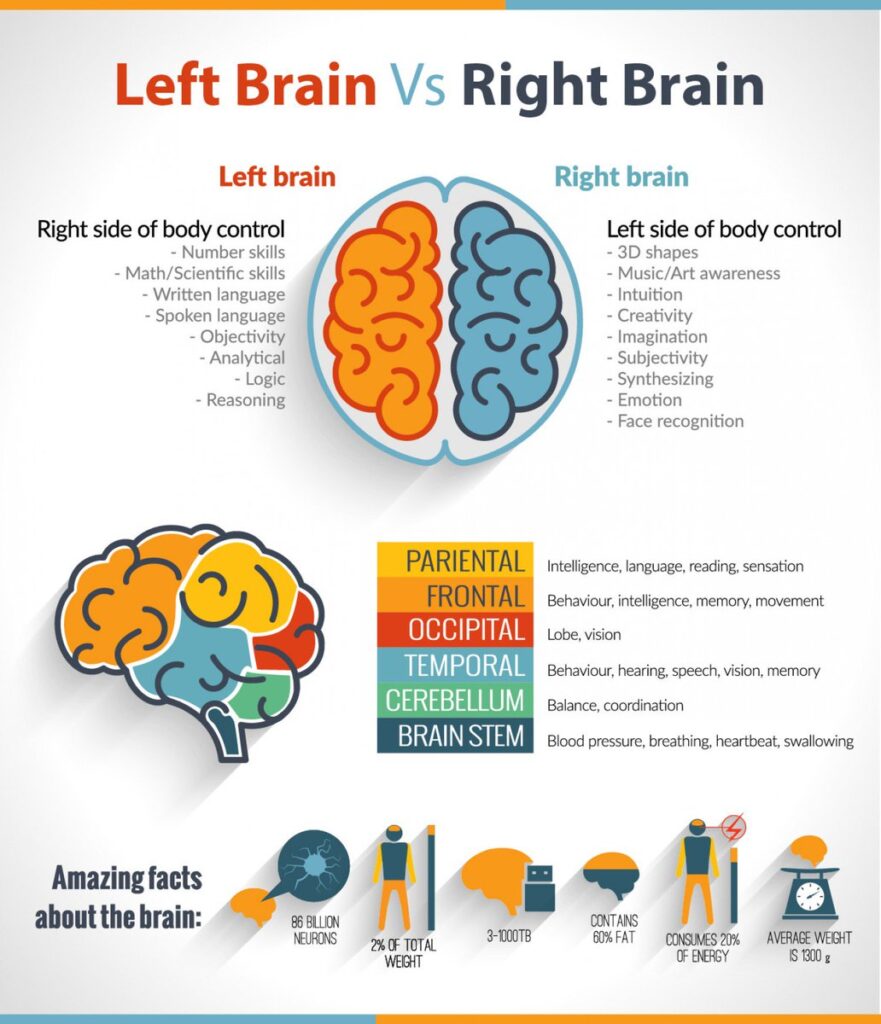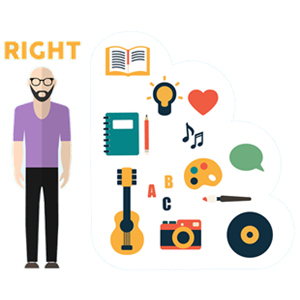
What is Brain Dominance?
According to conventional wisdom, people tend to have a Personality Type, a Thinking Style, or a way of doing things considered right-brained or left-brained, meaning that one side of their brain hemisphere is more dominant than the other!
There is evidence that some brain functions reside more on one side of the brain than the other. We know this partly from what is lost when a stroke affects a particular part of the brain.
Damage to the front part of the brain shows reduced motivation, difficulty planning, and impaired creativity.
We also know the back of the brain (the occipital cortex) integrates visual information from the eye, and damage to this area can cause partial or complete blindness.
These are just a few examples of how certain brain parts appear responsible for specific functions.
The brain’s two hemispheres are tied together by bundles of nerve fibers, creating a network, and one side isn’t generally more substantial than the other side unless damaged by trauma in some manner.
Okay, so we know that each side of our brain has dominant functions, but does it necessarily follow that we have a dominant brain hemisphere, just as we have a dominant hand?
Whether you’re performing logical reasoning or creative Thinking, you receive input from both sides of your brain. And although the two sides of your brain function differently, they work together and complement each other.
Even so, people seem to behave following a style that appears to come from one side over the other.
Right-Brain – Visual and Intuitive

Right-brain-dominant people are supposed to be intuitive and creative free thinkers.
They are “qualitative,” big-picture thinkers who experience the world in descriptive or subjective terms.
The right brain is more visual and intuitive. It’s sometimes referred to as the analog brain. It thinks more creatively and less organizedly.
- The right brain is more visual and intuitive.
- It’s sometimes referred to as the analog brain.
- It has a more creative and less organized way of Thinking.
- The right brain helps you understand context and tone.
- The right brain helps with comparisons and rough estimates.
Those who are right-brained are supposed to be intuitive and creative free thinkers.
They are “qualitative,” big-picture thinkers who experience the world in descriptive or subjective terms.
For example, their view of the weather would likely be…
“The skies are gray and menacing; I wonder if it’s going to rain?”
The right brain is connected to the following:
- Imagination.
- Holistic Thinking.
- Intuition.
- Arts.
- Rhythm.
- Nonverbal cues.
- Feelings.
- Visualization.
- Daydreaming.
Left-Brain – Verbal, Analytical, and Orderly

People with left-brain dominance tend to be more quantitative and analytical. They pay attention to details and are ruled by logic.
The left brain is more verbal, analytical, and orderly than the right. It’s sometimes called the digital brain. It’s better at things like reading, writing, and computations.
For example, the left brain is credited with language, but the right brain helps you understand context and tone.
The left brain handles mathematical equations, but the right brain helps with comparisons and rough estimates.
- Left-brained people tend to be more quantitative and analytical.
- The left brain is more verbal, analytical, and orderly than the right.
- It’s sometimes called the digital brain.
- The left brain is credited with language.
- The left brain handles mathematical equations.
- It’s better at things like reading, writing, and computations.
People with left-brain dominance pay attention to details and are ruled by logic.
For example, their view of the weather would likely be…
“The forecast said there was only a 30% chance of rain, but those cumulonimbus clouds will probably bring the thunder and rain.”
The left brain is connected to the following:
- Logic sequencing.
- Linear Thinking.
- Mathematics.
- Facts.
- They think in terms of words.
Bilateral-Balanced
Bilaterally balanced people seem to use both sides equally.
Left vs. Right Brian Personality Comparison
General personality traits, individual preferences, or learning styles don’t mean you’re left-brained or right-brained.
The right brain is associated with imagination, holistic Thinking, intuition, the arts, rhythm, nonverbal cues, feelings, and visualization, while the left brain deals with logic, sequencing, linear Thinking, mathematics, and facts.
Right-brained people are intuitive, creative thinkers, and “qualitative.” They like to think about the big picture and experience the world in descriptive or subjective terms.
On the other hand, left-brained people are more “quantitative” and analytical. They pay attention to details, prefer logical reasoning, are more verbal, and are better at reading, writing, and computations.
So, where the left brain handles mathematical equations, the right brain makes comparisons and rough estimates.
And while the left brain deals with language, the right brain enables you to understand context and tone.
Emotions Brain Dominance
- This is the right brain’s domain in humans and non-human primates.
- Emotions are expressed and recognized in others by the right brain.
Language Brain Dominance
- The left brain is more active in speech production than the right.
- In most people, the two main language areas, Broca’s and Wernicke’s areas, are found in the left hemisphere.
- Sign language Visually-based languages are also the domain of the left brain.
- People who are deaf show speech-like brain activity when watching sign language.
Left vs. Right-Handed Brain Dominance
- Left- and right-handed people use their left and right brains differently.
- For example, a left-handed person uses their right brain for manual tasks and vice versa.
- The side of the brain that is used for certain activities may be influenced by whether a person is left—or right-handed.
- Handedness is built and can even be detected while the baby is in the womb.
- Some babies prefer to suck their left or right thumb from as early as 15 weeks.
Attention Brain Dominance
- The left side of the brain is more involved with attention to the inner world.
- The right side is more interested in attending to the external world.
- Recent brain imaging studies have shown no differences between males and females regarding their brain lateralization.
- The side of the brain used in each activity is not the same for every person.


